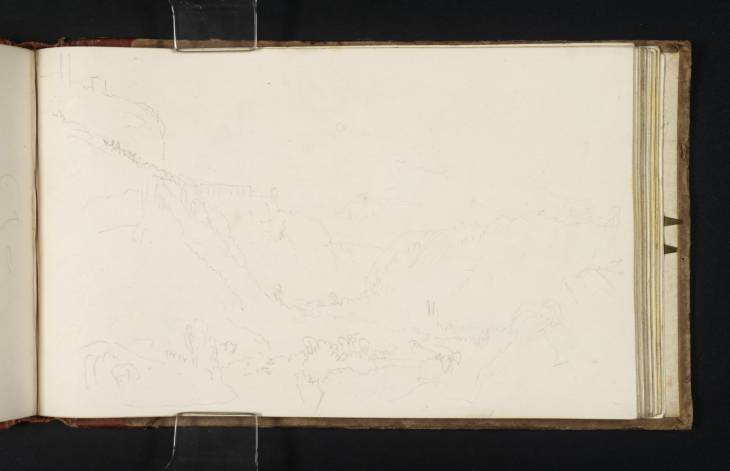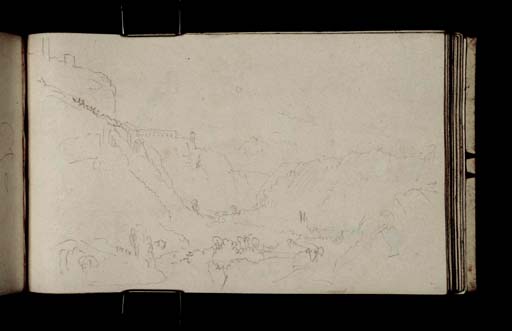Joseph Mallord William Turner The Santuario di Ercole Vincitore, Tivoli, seen from the Valley 1819
Image 1 of 2
Joseph Mallord William Turner,
The Santuario di Ercole Vincitore, Tivoli, seen from the Valley
1819
Joseph Mallord William Turner 1775–1851
Folio 46 Verso:
The Santuario di Ercole Vincitore, Tivoli, seen from the Valley 1819
D15013
Turner Bequest CLXXIX 46 a
Turner Bequest CLXXIX 46 a
Pencil on white wove paper, 112 x 186 mm
Accepted by the nation as part of the Turner Bequest 1856
References
1909
A.J. Finberg, A Complete Inventory of the Drawings of the Turner Bequest, London 1909, vol.I, p.528 as ‘Town on hill (?Tivoli)’.
Turner’s exploration of Tivoli included a large number of landscape sketches drawn from the river valley to the north. He was particularly attracted by the spectacle of the town’s ancient ruins perched above the steep, wooded gorge and streaming waterfalls. This study depicts the view looking south from the floor of the valley towards the Ponte dell’Acquoria. Silhouetted along the top of the hill to the left are the long arcades of the Santuario di Ercole Vincitore (Sanctuary of Hercules the Victor), a ruined Roman temple dedicated to the cult of Hercules. The low position of the sun in the west suggests that the artist must have observed the scene at late afternoon or early evening. Compositional precedents for the view include John ‘Warwick’ Smith (1749–1831), Villa of Mecenas, an engraved plate from the publication Select Views in Italy, which Turner copied in the Italian Guide Book sketchbook (see Tate D13966; Turner Bequest CLXXII19), and a drawing by James Hakewill (1778–1843), Villa of Maecenas and Cascatelle. Tivoli 1816 (British School at Rome Library), engraved for Hakewill’s Picturesque Tour of Italy, published in 1819.1
Formerly known as the Villa of Maecenas, the Santuario di Ercole Vincitore was one of Tivoli’s most popular picturesque motifs. It features in many of Turner’s 1819 sketches looking both up and down the valley, and he also made detailed tonal studies of the architecture and the arched passageway underneath the ruin’s substructures (see for example Tate D15486; Turner Bequest CLXXXIII 20). It was the vista from the north-east however, which seems to have held the greatest visual appeal. Similar views can be found on folios 47, 48 verso, 53 verso and 55 verso–56 (D15014, D15018, D15025, D15029–D15030), as well as in the Tivoli sketchbook (Tate D15469 and D41397; Turner Bequest CLXXXIII 3 and verso of 1) and in the Naples: Rome C. Studies sketchbook (Tate D16120–D16121; Turner Bequest CLXXXVII 32–3). Turner later considered developing the view for the Tivoli vignette illustration for Rogers’s Italy, 1830 (see Tate D27605; Turner Bequest CCLXXX 88), and ultimately revisited it within an oil sketch, Tivoli, the Cascatelle circa 1827–8 (Tate, N03388) and an unfinished painting, Tivoli: Tobias and the Angel circa 1835 (Tate, N02067).2
Nicola Moorby
February 2010
Tony Cubberley and Luke Herrmann, Twilight of the Grand Tour: A Catalogue of the drawings by James Hakewill in the British School at Rome Library, Rome 1992, no.5.3, p.226, reproduced.
How to cite
Nicola Moorby, ‘The Santuario di Ercole Vincitore, Tivoli, seen from the Valley 1819 by Joseph Mallord William Turner’, catalogue entry, February 2010, in David Blayney Brown (ed.), J.M.W. Turner: Sketchbooks, Drawings and Watercolours, Tate Research Publication, December 2012, https://www


